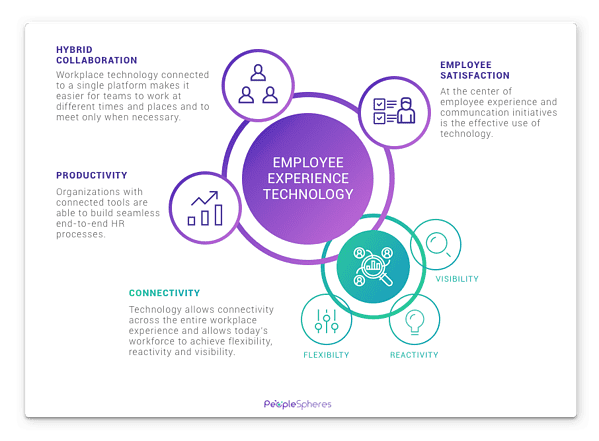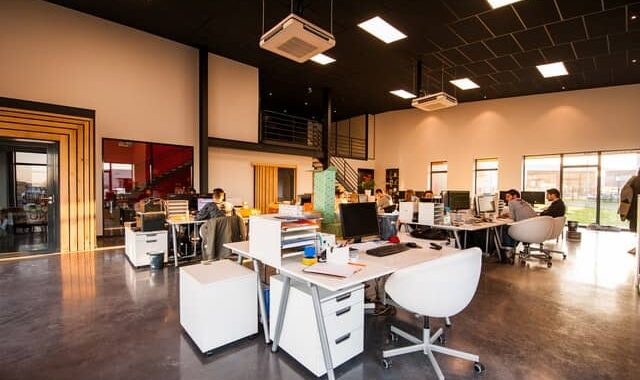
Since the year 2020, the concept of employee experience has been the buzz of the HR community. Today, the burning question for many large organizations is how to effectively manage the employee experience and how can this human-centric approach be scaled to all employees across an entire organization?
Experts are beginning to recognize that employee experience is made up of multiple elements: physical surroundings, work culture and technology. Many organizations have already invested in new technology and HR applications to improve the employee experience. However, employee experience management also requires organizations to adopt intentional strategies that leverage this technology in conjunction with the other elements of the employee experience. For this reason, IT and HR both play an important role in working side-by-side to develop these employee experience management strategies. The goal is to create experiences that generate long-term benefits and be able to scale these experiences across large, multi-matrix organizations.
In this article, we will define what employee experience management means, why it is important now more than ever, and how to use technology to harmonize employee experiences across an entire organization.
Related articles:
Agile is the New HR: Applying Agile Principles to HR Tech
Future HR Technology Trends: The HR Application Framework
Defining Employee Experience Management (EXM)
Employee experience management (EXM) is the process of creating and measuring employee experiences and identifying ways to improve the experiences throughout the entire employee journey. EXM is based on the understanding that employees are any company’s most valuable asset and that organizations with engaged employees achieve better business outcomes. However, employee experience management goes beyond employee engagement tactics. If done correctly, EXM allows organizations to drive positive outcomes such as improving employee productivity, reducing turnover, as well as increasing customer satisfaction.
Another way that EXM goes beyond employee engagement is the fact that it aligns employee experiences with the goals and vision of the entire company. In other words, it is not just a human resources initiative. It must be supported by cross-functional teams including IT, operations, finance, etc. in order to be able to scale across an organization. In fact, many companies consider employee experience just as important and integral to the success of their business as their customer experience strategies.
What is employee experience?
Let’s back up a second. What exactly do we mean when we talk about employee experiences? And how does one create an employee experience? Essentially, it is defined as every single encounter that an employee has with their employer and workplace. It is an accumulation of every perception and feeling that an employee experiences during the entire employee lifecycle. It starts when they first apply for a position and does not stop until they leave the company. Even then, their experiences during their time working at your company can impact the employer brand, which in turn impacts talent acquisition and employee retention.
Just like every customer experience is unique, so is every employee experience. We all fill different roles in an organization, have different needs, work with different tools, with different people and even in different times and places. Because of this, it is not possible to have a one-size-fits-all approach to EXM. Not only is it crucial to personalize experiences to address employees’ needs, pain points and individual motivators, it is what employees today are expecting from their employers.
Why Employee Experience Management is Important
Whether you are aware of it or not, every one of us inevitably has employee experiences. Employee experience management allows business leaders to take control of what these experiences look like and the impact that they have on the business.
Furthermore, there are a number of compelling reasons that employee experience is so important to businesses. Not only did the pandemic take a toll on workers over the past couple of years but recruiting and retaining talent has becoming significantly more difficult for employers as well. As a result, optimizing the employee experience can offer long-term benefits which can even turn into a competitive advantage. These benefits include:
- Better performance – the way we work is different from what it was a couple of years ago. Today technology helps employees make better, quicker decisions by obtaining and communicating essential information more efficiently.
- Reduce employee turnover – engaged employees are less likely to quit, which as a result, reduces the cost of replacing your top talent.
- Increased profits – a Harvard researcher found that companies that invest in employee experience added an average four times more to their bottom line than those that do not.
- Improved customer satisfaction – a positive employee experience can have a ripple effect through the entire operation, rubbing off on everything from how engaged employees are to their keenness to deliver a superior customer experience.
Workforce engagement, productivity and financial outcomes are directly linked to the experiences that employers create. Recognizing this relationship between experience and the opportunity for profitability and business growth, business leaders are setting out to building a fruitful employee experience.
How to Improve the Employee Experience with Technology
Collaboration
How employees communicate and collaborate is changing as a result of the transition to a more flexible work environment. In the 2021 Willis Towers Watson Employee Experience Survey, an average of eight out of ten firms acknowledged that the current realities of labor markets require a hybrid working environment for many jobs. They understand, however, that they are not equipped to make that commitment. Given that one out of every four workers are likely to undertake a combination of onsite and remote work over the next three years, this is an important factor to be aware of.
During this era of rapid technological evolution, innovative solutions are paramount for optimizing employee experience. By leveraging enhanced technology like Lighthouse AI, companies can develop bespoke tools to synergize with existing frameworks, surpassing standard engagement measures. With a strategic fusion of internal and cutting-edge technologies, businesses amplify their potential to customize digital workspaces that reflect unique company cultures and operational needs.
The resources needed to align HR activities with the reality and future of work is what employee experience technology brings to the table. As employees become increasingly reliant on technology, HR must adapt its support for virtual onboarding, learning, employee engagement, and performance.
Connectivity
Technology provides for connectedness for employees throughout the whole work environment, not just among our traditional office workers. The notion of connectivity grants today’s workforce the following:
- Flexibility – because employee experience systems offer great mobile capabilities, employees have all the tools they need to execute their tasks efficiently at their fingertips.
- Visibility – being able to connect tools also entails being able to centralize data. Organizations can reap the benefits of a decentralized organization while maintaining the visibility of a centralized operation by using a single database for all HR tools.
- Reactivity – in today’s corporate environment, where things change quickly, it’s critical to be able to make quick decisions. Organizations can be more reactive and agile as a result of both software and human connection.
📈 Case Study: Improving Employee Experience in Large Enterprises
The INTRASIPA Group, emerging from the 2020 merger of SIPA and the Ouest France group, faced significant challenges in unifying its vast and diverse workforce. With 5,600 employees spread across 32 companies and 357 brands, the group struggled to provide a cohesive employee experience.
Their existing HR system, comprised of numerous unconnected tools, led to a disjointed and inadequate experience for employees, often resulting in an overwhelming workload for HR staff. Recognizing the need for a comprehensive solution, INTRASIPA embarked on a transformative journey to enhance its HR processes. By adopting a digitalized, flexible, and personalized HR system, the group aimed to create a unified umbrella for all employees, irrespective of the brand they represented.
This strategic shift not only streamlined HR processes but also played a crucial role in fostering a sense of identity and inclusion among the diverse workforce. The successful implementation of this system illustrates the pivotal role of innovative HR solutions in improving employee experience in large, multifaceted organizations like INTRASIPA.
Productivity
The increase in the volume of information and technology we are exposed to daily has made certain elements of work more difficult, but it has also opened new opportunities in others. Using the correct technology may make workers’ lives simpler at work, allowing them to stay connected, engaged, and ultimately more productive. The potential of automated, cross-application workflows is one way that employee experience technology may help boost productivity. Connected solutions enable organizations to create a smooth end-to-end onboarding process, from job application through job training. Even if they use several applications and tools to complete the task, making the process appear as unified workstream.
Employee Satisfaction
Employee satisfaction is not about the perks. It’s not about ping-pong tables and free gym memberships or even annual job satisfaction surveys. It’s a different type of investment in your employees and their quality of work life. It’s about meeting their expectations by listening to what they need, what motivates them to stay and delivering it in a way that empowers employees to do meaningful work. Employers need to use employee feedback to address the employee experience just like they would if they were dealing with an important client.
At the center of employee experiences that lead to satisfaction is the effective use of technology. For instance, when all the information an employee needs to get their job done is easily accessible, it empowers them to be more proactive and make good decisions in their work. Turning disengaged employees to engaged employees makes them perform better, and they are more satisfied in their job as a result.

Enhance your Employee Experience with the PeopleSpheres HR Platform
PeopleSpheres’ innovative solution helps connect your tools, your people, and your data. It is an HR platform solution that uses smart technology to provide a seamless employee experience to your global workforce. At a time where the very definition of “employee” is shifting and being redefined, PeopleSpheres has stepped in to help HR leaders be agile and adapt to the everchanging world.
Composable Application
The PeopleSpheres solution is based on a composable application framework to bring customers an open architecture HR system. You decide which tools on the market are right for your business and we connect them all to a single user interface and database. You define your HR processes based on your business needs. And you customize the employee experience to align with your business goals and company culture. It’s your system, your way and not the other way around.
Agility
Anyone who works in or with HR knows that nothing ever stands still. The reality is that drastic changes which require us to quickly pivot and adapt the way we do business. However, many HR systems are not nimble or flexible enough to provide HR with agility they need. With the flexibility of the PeopleSpheres solution, HR leaders gain the agility needed to provide each employee with the best possible experience. Furthermore, centralized data creates holistic visibility to actionable metrics and allows business leaders to become more data-driven decision makers.




-640x380.jpg)